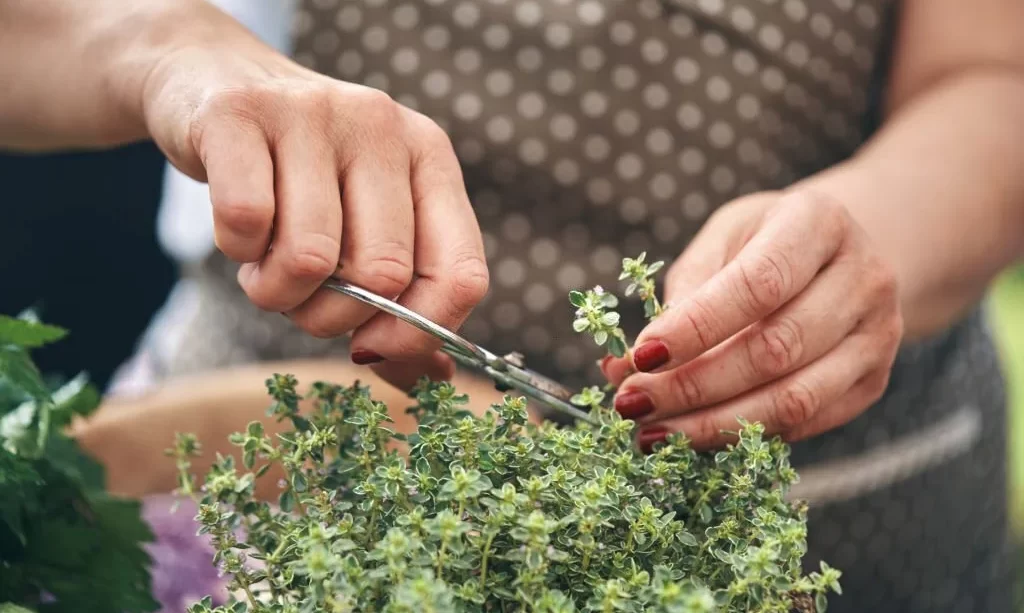Thyme, with its aromatic leaves and delightful flavor, is a must-have herb in any garden or kitchen. If you want to expand your thyme collection or share this versatile herb with others, propagating thyme is a simple and rewarding way to do it. In this guide, we’ll take you through the process of propagating thyme, providing you with clear and easy-to-follow steps to ensure success.
- STARTER HERBS: This four pack of Thyme will make a great start to your herb garden or addition to your current garden!
- GROWTH: Thyme grows to be about 12 inches tall and 12 inches wide.
- CARE: Thyme prefers a location with full sun and loamy, well-draining soil. It doesn’t require frequent watering, so let the soil dry out completely and then water thoroughly about once a month or as needed.
- FUN FACT: Thyme was seen as a symbol of courage and strength so in ancient Greece, it was given to soldiers as they were going into battle.
- LIVE PLANTS: Our plants are grown exclusively for Deep Roots and The Three Company, shipped fresh directly from our greenhouse to you!
Choose Your Propagation Method
Propagating thyme can be done through various methods, each with its own advantages. Let’s explore the options:
- Seeds: Starting thyme from seeds is an economical choice, but it requires patience as it takes longer to establish.
- Cuttings: Propagating from cuttings is a quicker method. You can take stem cuttings from an existing thyme plant and root them to create new plants.
- Division: If you have an established thyme plant, division allows you to separate it into smaller sections, each of which can grow into a new thyme plant.
Selecting the right propagation method that suits your needs and resources is the first step towards successfully propagating thyme.
Prepare Your Tools and Materials
Before you begin propagating thyme, it’s essential to gather the necessary tools and materials based on your chosen propagation method:
- For Seed Propagation: You will need seed trays or small pots, high-quality seed starting mix, and thyme seeds. Ensure the containers have drainage holes.
- For Cutting Propagation: Prepare a sharp knife or scissors for taking cuttings, rooting hormone (optional but helpful for faster rooting), small pots or trays filled with well-draining potting mix, and a spray bottle for maintaining humidity.
- For Division: If you opt for division, you’ll need a spade or garden fork to carefully separate the parent plant and pots or suitable planting spots with well-draining soil.
Having these tools and materials ready will make the propagation process smoother and more efficient.
Propagate Thyme
Depending on your chosen method, follow these steps to propagate thyme:
From Seeds:
- Fill seed trays or small pots with seed starting mix.
- Sow thyme seeds on the surface of the mix, spacing them according to package instructions.
- Gently press the seeds down, so they make good contact with the soil.
- Water the soil lightly.
- Cover the trays or pots with a plastic lid or a clear plastic wrap to create a mini greenhouse effect.
- Place the containers in a warm, well-lit area with indirect sunlight.
- Keep the soil consistently moist but not waterlogged.
- Once seedlings have several sets of true leaves, transplant them into larger pots or your garden.
From Cuttings:
- Take 4-6 inch (10-15 cm) stem cuttings from a healthy thyme plant, making sure to choose non-flowering stems.
- Remove the leaves from the lower part of the cutting.
- Optionally, dip the cut end in rooting hormone to promote root growth.
- Plant the cuttings in pots filled with well-draining potting mix.
- Water the cuttings thoroughly and place them in a warm, brightly lit location, avoiding direct sunlight.
- Keep the soil consistently moist.
- Roots should form within a few weeks, at which point you can transplant the new thyme plants.
From Division:
- Carefully dig up an established thyme plant.
- Gently separate the plant into smaller sections, making sure each section has roots attached.
- Replant the divisions in pots or directly in your garden, spacing them appropriately.
- Keep the soil consistently moist until the divisions establish themselves.
By following these steps, you’ll successfully propagate thyme using your chosen method, allowing you to enjoy an abundance of this aromatic herb in your garden or share it with fellow gardeners and culinary enthusiasts.
Provide Proper Care
Proper care is essential to ensure the healthy growth of your newly propagated thyme plants, regardless of the method you chose. Here are some key care tips:
- Watering: Thyme prefers well-drained soil. Water your thyme plants when the top inch (2.5 cm) of soil feels dry. Avoid overwatering, as thyme is susceptible to root rot.
- Sunlight: Thyme thrives in full sunlight. Provide your plants with at least 6 hours of direct sunlight daily for robust growth and flavorful leaves.
- Pruning: Regularly trim or pinch back the tips of your thyme plants to encourage bushier growth. Pruning also helps maintain the plant’s shape and prevents it from becoming leggy.
- Fertilizing: Thyme doesn’t require heavy fertilization. A light application of balanced, all-purpose fertilizer in the spring is usually sufficient. Avoid excessive nitrogen, which can lead to excessive leaf growth at the expense of flavor.
- Protection: Shield young thyme plants from extreme heat or cold, especially during their early stages of growth. Consider using mulch to regulate soil temperature.
- Package contains 50 organic herb fertilizer spikes and are produced to avoid wasteful runoff, mess, hazards and smells
- Formulated with a 4-3-3 NPK to ensure a continuous supply of nutrients below the surface, where the plants active roots are growing
- Jobe’s organic fertilizer spikes contain no synthetic chemicals and are OMRI listed for organic gardening by the USDA
- Application is simple and should be done at the time of planting or early in the growing season
- Jobe’s fertilizer spikes are pre-measured to provide the right amount of nutrients for herbs without risk of over fertilizing
Conclusion
Propagating thyme allows you to expand your herb garden, ensuring a steady supply of this aromatic and flavorful herb for culinary delights. Whether you choose to propagate thyme from seeds, cuttings, or division, the key is to provide the right care, including proper watering, sunlight, pruning, and protection from harsh weather conditions.
As your propagated thyme plants flourish, you’ll not only enjoy the delightful flavor they add to your dishes but also appreciate the satisfaction of nurturing new plants from your existing ones. So, go ahead and propagate thyme—it’s a rewarding gardening endeavor that will enhance your culinary adventures.





